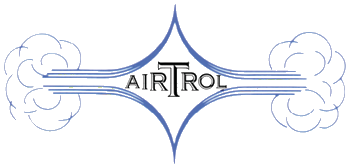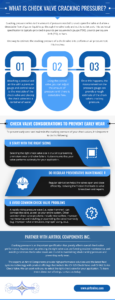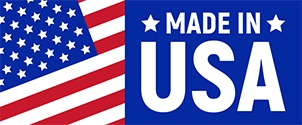Check valves are used in various tubing and pipeline systems to control the flow of liquid or gas. One critical specification of check valves is their cracking pressure, which affects the check valve’s reseal pressure and overall performance. Factors such as selecting the right valve size, performing preventative maintenance, and checking for common check valve problems will prevent early wear and help maintain the ideal cracking pressure for your application.
What is Check Valve Cracking Pressure?
Cracking pressure refers to the amount of pressure needed to crack open the valve and allow a detectable flow of gas or liquid to go through the valve body and out its outlet port. This technical specification is typically provided in pounds per square inch gauge (PSIG), pounds per square inch (PSI), or bars.
One way to estimate the cracking pressure of a check valve is to perform an air pressure test. This involves attaching a pressurized air line with a pressure gauge and control valve to the inlet side of the check valve and placing the check valve into a container of water. Using the control valve, you can adjust the amount of pressure until there is detectable flow. Once this happens, the measurement on the pressure gauge can provide a rough estimate of the check valve’s cracking pressure.
How Check Valve Cracking Pressure Affects Reseal Pressure and Performance
Reseal pressure refers to the amount of backflow pressure needed to close the check valve tightly enough to prevent detectable flow. Until the reseal pressure is reached, the check valve will not close under reverse flow conditions.
Failure to meet reseal pressure is a common issue that affects check valve performance. Since resealing is spring-aided, check valves with lower cracking pressures require higher reseal pressures to form a bubble-tight seal. Failing to meet the required reseal pressure can result in the check valve bleeding fluid backward, which can be extremely dangerous in some systems.
Check Valve Considerations to Prevent Early Wear
To prevent early wear and maintain the cracking pressure of your check valves, it is important to do the following:
Start With the Right Sizing
Selecting the right check valve size is crucial to preventing premature wear and valve failure. It also ensures that your valve performs optimally for your application. Sizing a valve based on application rather than pipe/tubing size typically results in better operating conditions.
Do Regular Preventative Maintenance
Regular lubrication helps the valves open and close efficiently, reducing the friction that leads to valve breakdown and repairs. Using filters or covers for gas applications and performing regular pump flushing for liquid applications ensures that your system remains clean, which will prolong the service life and prevent early wear.
Avoid Common Check Valve Problems
A rapidly rising pressure wave (i.e. water hammer) can damage the valve, as well as your entire system. Other common check valve problems include reverse flow, improper maintenance, and installing or assembling the valve incorrectly (e.g. improper valve orientation, improper sizing, etc.).
Partner with Airtrol Components Inc.
Cracking pressure is an important specification that greatly affects overall check valve performance. Aspects such as selecting the right valve size, performing routine maintenance, and avoiding common check valve issues are crucial in maintaining ideal cracking pressure and preventing early wear.
The experts at Airtrol Components provide high-performance solutions and the latest fluid systems technology with product offerings that include the CV-125 Check Valve and CV-062 Series Check Valve. We can work with you to select the right check valve for your application. To learn more about our offerings, contact us today.


